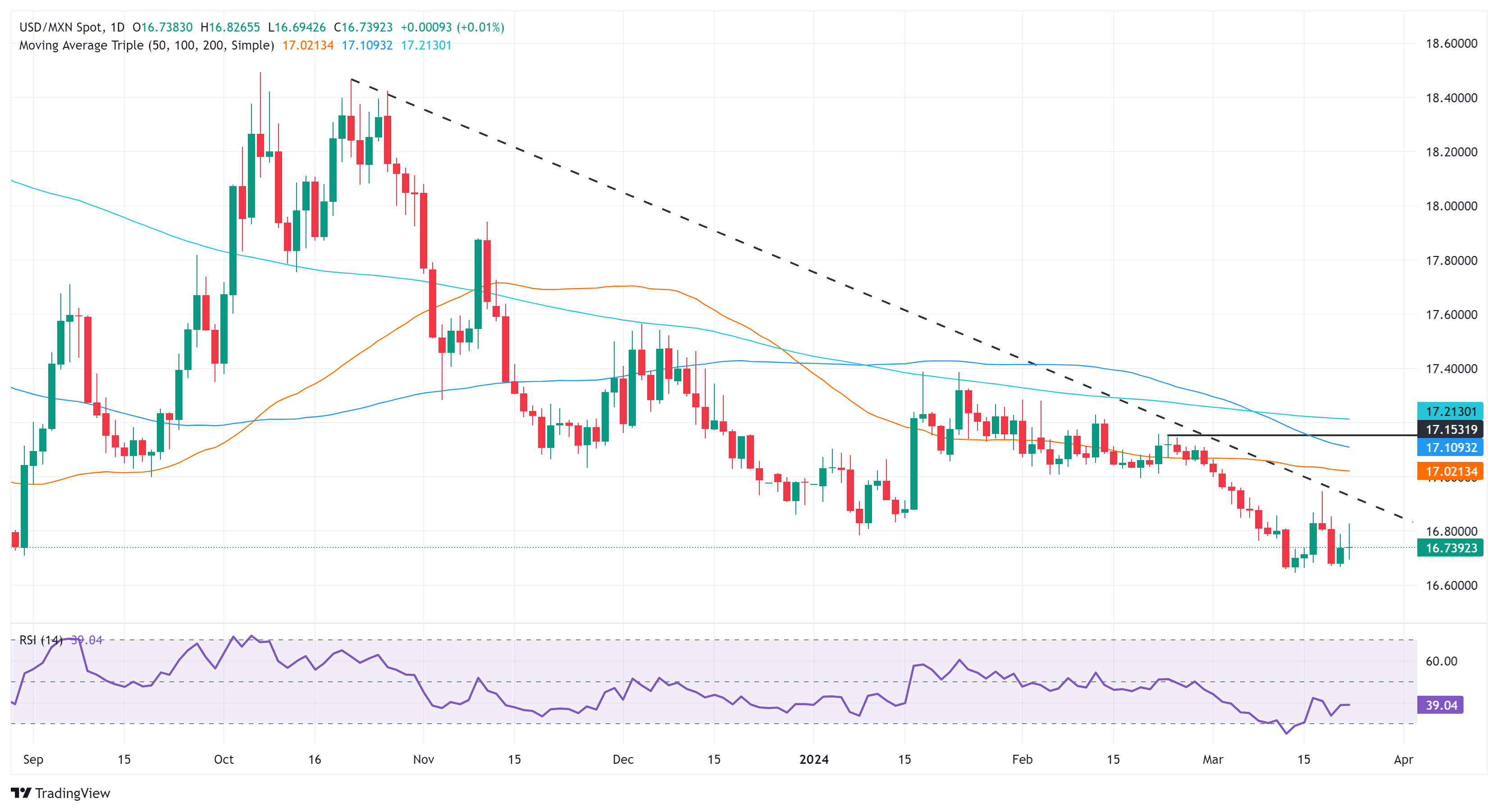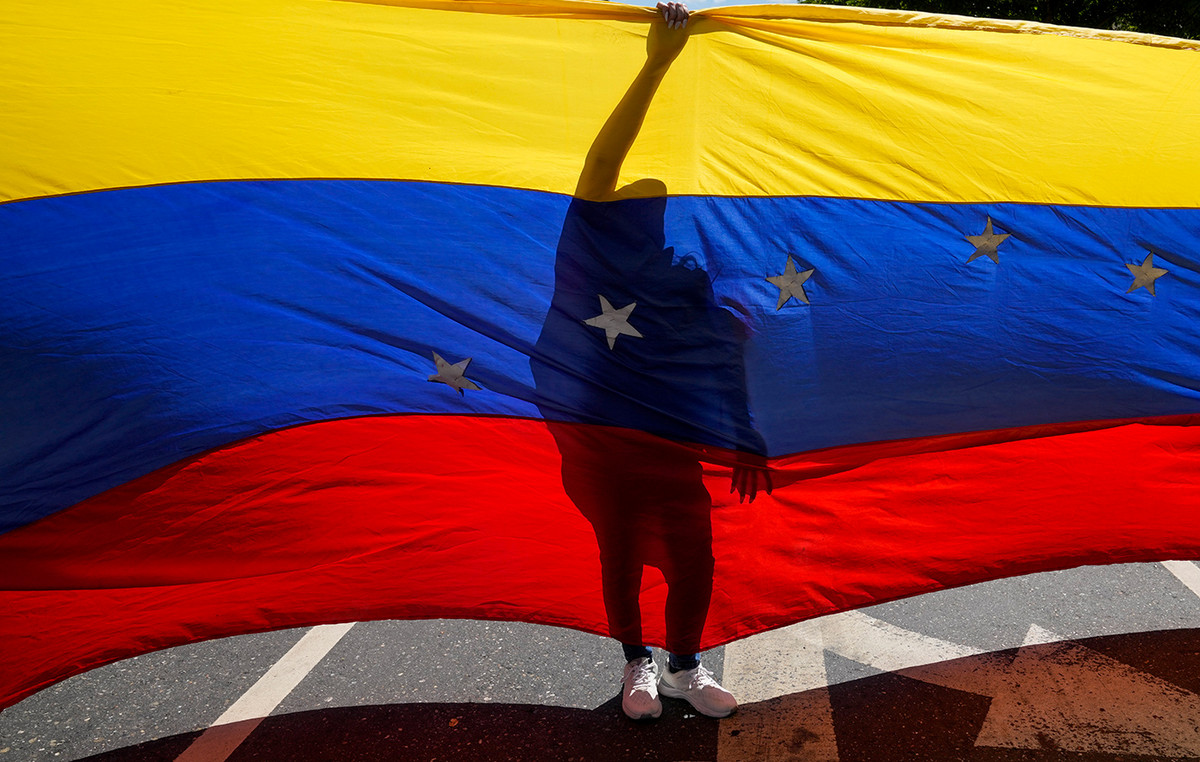- The Mexican peso loses steam while the USD/MXN cuts initial losses.
- Banxico's split decision to cut rates to 11.00% offers a nuanced outlook, contributing to the Peso's resilience.
- Mexico's economic results show a contraction in January and high inflation data.
- Banxico underlines a data-dependent approach, with an inflation target of 3% for the second quarter of 2025.
The Mexican Peso (MXN) lost ground late on Friday against the US Dollar (USD) after both central banks, the Federal Reserve (Fed) and the Bank of Mexico (Banxico), decided to maintain and cut interest rates in the midst of their separate evolutions of disinflation. The emerging market currency began to show signs of weakness even though Banxico's vote split provided a more balanced tone in the Governing Council. USD/MXN is trading at 16.76, up 0.15%.
Mexico's economic data revealed on Friday that the economy shrank in January from December, while the mid-month inflation report beat estimates on a monthly basis and in the 12 months through March.
On the other hand, Banxico's decision to lower interest rates was not felt in the USD/MXN exchange rate, although the interest rate differential between the Mexican Central Bank and the Fed contracted. The Banxico Governing Board reduced the main reference rate to 11.00%, although it emphasized that it will depend on the data in future monetary policy meetings.
The Bank of Mexico expressed that the policy remains restrictive, that the disinflation process will continue and that it hopes to reach its goal of 3% in the second quarter of 2025.
Daily summary of market movements: Mexican peso strengthens despite the reduction in the rate differential
- Inflation in Mexico exceeded estimates of 4.45%, increasing 4.48%, while underlying figures jumped above the consensus of 4.62% annually and rose 4.69%, the National Statistics Institute (INEGI) revealed on Friday. Furthermore, economic activity fell -0.6% monthly, below estimates of a 0.3% expansion, and slowed compared to December, below estimates of 2.6%, falling to 2%.
- The outlook in Mexico suggests stagnation of the economy. The weakness of the retail sales report, the sharp drop in private spending and the contraction of economic activity justified Banxico's rate cut. However, they face stubborn inflation, which keeps policymakers on edge.
- Mexico's retail sales fell 0.6% monthly in January, below estimates for a 0.4% expansion but better than December data. The annual figures plummeted from -0.2% to -0.8%, destroying forecasts for a 1.2% expansion.
- Aggregate demand rose 0.3% quarter-on-quarter in the fourth quarter, up from 0%. In annual terms, it slowed from 2.7% to 2.6%.
- Quarterly private spending slowed from 1.2% to 0.9%. In annual terms, it improved from 4.3% to 5.1%.
- Traders are digesting the latest monetary policy decision from the Federal Reserve, which kept rates unchanged and maintained its guidance for three 25 basis point rate cuts by the end of the year. Despite revising the level of the federal funds rate (FFR) upward to 3.9%, the Fed's decision was perceived as moderate.
- Following the Fed's decision, money market traders see a 73.2% chance that the Federal Reserve will cut rates by a quarter of a percentage point.
Technical analysis: USD/MXN accelerates to 16.80
The USD/MXN daily chart suggests that buyers are losing momentum, with the pair poised to test lows last seen in 2015. The failure of buyers to conquer the 17.00 figure following Banxico's rate cut suggests that the supply is greater than demand. In that scenario, the pair's first level of support would be the current year-to-date low of 16.64, followed by last year's cycle low of 16.62 and the October 2015 low of 16.32.
For a bullish scenario, traders need to reclaim the current week's high of 16.94, before 17.00. Below are key dynamic resistance levels such as the 50-day SMA at 17.01, the 100-day SMA at 17.11, and the 200-day SMA at 17.20.
USD/MXN Price Action – Daily Chart

Frequently Asked Questions about the Mexican Peso
What is MXN?
The Mexican Peso is the legal tender of Mexico. The MXN is the most traded currency in Latin America and the third most traded on the American continent. The Mexican Peso is the first currency in the world to use the $ sign, prior to the later use of the Dollar. The Mexican Peso or MXN is divided into 100 cents.
What is Banxico and how does it influence the MXN?
Banxico is the Bank of Mexico, the country's central bank. Created in 1925, it provides the national currency, the MXN, and its priority objective is to preserve its value over time. In addition, the Bank of Mexico manages the country's international reserves, acts as a lender of last resort to the banks and advises the government economically and financially. Banxico uses the tools and techniques of monetary policy to meet its objective.
How does inflation impact the MXN?
When inflation is high, the value of the Mexican Peso (MXN) tends to decrease. This implies an increase in the cost of living for Mexicans that affects their ability to invest and save. At a general level, inflation affects the Mexican economy because Mexico imports a significant amount of final consumption products, such as gas, fuel, food, clothing, etc., and a large amount of production inputs. On the other hand, the higher the inflation and debt, the less attractive the country is for investors.
How does the Dollar influence the Mexican Peso (MXN)?
The exchange rate between the USD and the MXN affects imports and exports between the United States and Mexico, and may affect demand and trade flows. The price of the Dollar against the Mexican Peso is affected by factors such as monetary policy, interest rates, the consumer price index, economic growth and some geopolitical decisions.
How does the Fed's monetary policy affect Mexico?
The exchange rate between the USD and the MXN affects imports and exports between the United States and Mexico, and may affect demand and trade flows. The price of the Dollar against the Mexican Peso is affected by factors such as monetary policy, interest rates, the consumer price index, economic growth and some geopolitical decisions.
Source: Fx Street
I am Joshua Winder, a senior-level journalist and editor at World Stock Market. I specialize in covering news related to the stock market and economic trends. With more than 8 years of experience in this field, I have become an expert in financial reporting.







